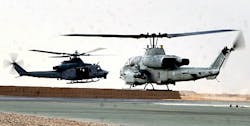Bell Helicopter prepares to build 25 new UH-1Y and AH-1Z helicopters for U.S. Marine Corps
PATUXENT RIVER NAS, Md., 2 April 2013.Combat helicopter designers at Bell Helicopter Textron Inc. in Fort Worth, Texas, are making preparations to build 25 new military helicopters for the U.S. Marine Corps under terms of a $13.1 million contract announced Monday.
The contract calls for Bell Helicopter to provide long lead parts and components to build 15 Lot 11 UH-1Y combat utility helicopters and 10 Lot 11 AH-1Z attack helicopters. Long-lead parts take a relatively long time to acquire, and represent an essential first step in a major manufacturing program.
Awarding the contract were officials of Naval Air Systems Command at Patuxent River Naval Air Station, Md.
The UH-1Y is an armed twin-engine utility helicopter with modern avionics, powerful engines, and four-bladed rotor system designed to replace the ageing Marine Corps fleet of two-blade-roter UH-1N light utility helicopters.
The helicopter's new engines and four-bladed rotor provide increased power sufficient to lift new avionics, radios, and door guns necessary for today's Marine Corps operations. The UH-1Y has a glass cockpit, forward-looking infrared sensors, new engines, and four-blade rotor.
The UH-1Y can lift a useful load of 6,660 pounds, can fly at speeds of nearly 200 knots, to altitudes as high as 20,000 feet, and can fly for more than three hours between refuelings. It can carry machine guns and fire 70-millimeter Hydra rockets.
The AH-1Z, meanwhile, is a twin-engine attack helicopter based on the AH-1W SuperCobra that features a four-blade rotor system, uprated transmission, and a new target sighting system. It has upgraded avionics, weapons, and electro-optical sensors designed to find targets at long ranges and attack them with precision weapons.
At the heart of the AH-1Z weapons systems is the Lockheed Martin/Northrop Grumman AN/APG-78 Longbow fire-control radar designed originally for the U.S. Army's AH-64 Apache attack helicopter. The helicopter can carry a payload of 5,764 pounds, can fly as fast as 222 knots, has a range of 370 nautical miles, and can fly as high as 20,000 feet.
The AH-1Z has a crew of two, and carries a 20-millimeter Gatling gun, and can fire 70-millimeter Hydra rockets, AIM-9 Sidewinder air-to-air missiles, and AGM-114 Hellfire air-to-ground missiles.
Together the UH-1Y and AH-1Z are part of the Marine Corps H-1 program to build new attack and utility helicopters with design commonality to keep costs down. The UH-1Y and AH-1Z share a common tail boom, engines, rotor system, drive train, avionics architecture, software, controls, and displays. More than 84 percent of the two helicopters' components are identical.
On the current contract, Bell Helicopter will do the work in Fort Worth and Amarillo, Texas, and should be finished in September 2014.
For more information contact Bell Helicopter online at www.bellhelicopter.com, or Naval Air Systems Command at www.navair.navy.mil.

